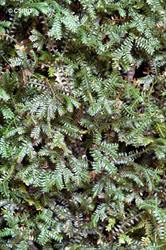Selaginellaceae
Australian Tropical Ferns and Lycophytes - Online edition
Selaginella australiensis
Selaginella australiensis Baker
Link to Australian Plant Name Index for publication details and synonyms: https://id.biodiversity.org.au/name/apni/75860
Stems slender, wide-creeping, repeatedly branched, rooting at dichotomies; branches low, ascending or procumbent. Median leaves narrowly ovate, to c. 2 mm long, keeled; base symmetrical, cordate, oblique; margins finely toothed; apex attenuate, acute and recurved. Lateral leaves sessile, oblong to oblong-ovate, c. 2.5 mm long, 1 mm wide, dark green, more widely spaced below, contiguous or overlapping above, dimidiate; margins usually dentate-ciliate on rounded acroscopic base and often finely dentate towards apex, otherwise entire; apex abruptly narrowed, obtuse. Spikes to 8 cm long, 1–1.5 mm wide, usually erect, terminal on ultimate branches; sporophylls homophyllous, similar to median leaves, overlapping. Megaspores 650–750 µm diam., faintly reticulate. Microspores 27–35 µm diam., rugose.
Endemic to NE QLD and E QLD.
Terrestrial, usually near creeks or rock formations in rainforest.
Easily grown on the floor of a tropical or subtropical fernery.
Identified from other creeping species by its long erect strobili. The lateral leaves are all of the same length and perpendicular to the stem, even on young shoots.
Field AR, Quinn CJ, Zich FA (2022) Australian Tropical Ferns and Lycophytes. apps.lucidcentral.org/fern/text/intro/index.htm (accessed online INSERT DATE).
Field AR, Quinn CJ, Zich FA (2022) ‘Platycerium superbum’, in Australian Tropical Ferns and Lycophytes. apps.lucidcentral.org/fern/text/entities/platycerium_superbum.htm (accessed online INSERT DATE).









